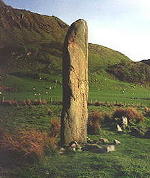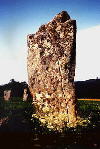
The People and the Sky
A description of the significance of the sun, moon and stars in the lives of the people of Scotland before the industrial revolution.
Stones
of Wonder
QUICK LINKS ...
HOME PAGE
INTRODUCTION
WATCHING
THE SUN, MOON AND STARS
THE
MONUMENTS
THE
PEOPLE AND THE SKY
BACKGROUND
ARCHAEOASTRONOMY
USING
THE SITE DESCRIPTION PAGES
VISITING
THE SITES
THE
LEY LINE MYSTERY
THE
SITES
ARGYLL
AND ARRAN
MID
AND SOUTH SCOTLAND
NORTH
AND NORTH-EAST SCOTLAND
WESTERN
ISLES AND MULL
Data
DATES
OF EQUINOXES AND SOLSTICES, 1997 to 2030 AD
DATES
OF MIDSUMMER AND MIDWINTER FULL MOONS, 1997 to 2030 AD
POSTSCRIPT
Individual
Site References
Bibliography
Links
to other relevant pages
Contact
me at : rpollock456@gmail.com
 Up
to the time of the industrial revolution, the mainly rural population
of Scotland retained a living interest in the sun, moon and stars; there
are many sources from the eighteenth century confirming this. Some of
the most celebrated of these sources are the books 'A
description of the Western Isles of Scotland'
and 'A
Voyage to St Kilda' by
Martin Martin, published about 1700. Even a casual reader of these books
will be struck by dozens of references to customs obviously derived from
a time when the sun and moon were gods or goddesses, and to the behaviour
of a people who still had a living relationship with the sky.
Up
to the time of the industrial revolution, the mainly rural population
of Scotland retained a living interest in the sun, moon and stars; there
are many sources from the eighteenth century confirming this. Some of
the most celebrated of these sources are the books 'A
description of the Western Isles of Scotland'
and 'A
Voyage to St Kilda' by
Martin Martin, published about 1700. Even a casual reader of these books
will be struck by dozens of references to customs obviously derived from
a time when the sun and moon were gods or goddesses, and to the behaviour
of a people who still had a living relationship with the sky.
The most interesting feature of these customs is that they were often combined with the Christian tradition to sometimes bizarre effect. For example, when arriving on one island from another, travellers would walk sunways around the church before conducting any business [Martin 1703, page 278]. On saints' days, there would be a walk to the well, and a sunwise tour [Ibid, page 303]. After child-bearing, fire would be carried around a the woman sunwise before she was taken to church, and the same would be done to the infant before it was christened [Ibid, page 177]. When the minister visited North Rona, the natives would express their esteem for him by taking a turn around him sunwise, and wishing him all happiness [Ibid, page 100]. After a dangerous landing on the Flannan Isles, Lewis fishermen would uncover their heads, make a sunwise turn, and thank God for their safety [Ibid, page 97]. When setting out on a fishing trip. the boat would be turned sunwise by the fishermen to ensure their safe return [Ibid, page 177]. On Skye, the sunwise tours were made around the ancient chambered cairns [Ibid, page 205].
The influence of the moon on human affairs was felt to be direct. Anyone who injured themselves at the change of the moon would suffer the injury at every change thereafter [Ibid, page 145], or afflictions would only recur at the change [Ibid, pages 118, 94, 234]. Shell-fish were thought to be plumper as the moon was waxing [Ibid, page 201], and peats would only be cut when the moon was waning, to ensure they dried out and burned well [Ibid, page 222]. The St Kildans sailors and fishermen did not use a compass, but navigated by the sun, moon and stars [Ibid, page 460]. Finally, to quote Martin Martin directly, the St Kildans used the sun and the moon in their daily lives in ways which by our own time have waned utterly away -
'[They] know the time of day by the motion of the sun from one hill or rock to another; upon either of these the sun is observed to appear at different times; and when the sun doth not appear, they measure the day by the ebbing and flowing of the sea, which they can tell exactly, though they should not see the shoar for some days together; their knowledge of the tides depends on the changes of the moon, which they likewise observe, and are very nice [i.e. accurate] in it... ' [Ibid, page 460]
